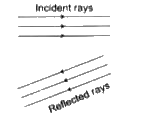Figure, shown two converging lenses. Incident rays are parallel to the principal axis. What should be the value of d so that final rays are also parallel?
Here, the diameter of ray beam become wider.

Final rays should be parallel. For this the II focus of L1 must coincide with l focous of L2
d=10+20
=30cm
Here the diameter of ray becomes wider.

Topper's Solved these Questions
- GEOMATRICAL OPTICS BOOK - RESONANCECHAPTER - GEOMATRICAL OPTICS EXERCISE - Problem
33 Videos
- GEOMATRICAL OPTICS BOOK - RESONANCECHAPTER - GEOMATRICAL OPTICS EXERCISE - Exercise-1
142 Videos
- EXPERIMENTAL PHYSICSBOOK - RESONANCECHAPTER - EXPERIMENTAL PHYSICSEXERCISE - PART -II
10 Videos
- GRAVITATIONBOOK - RESONANCECHAPTER - GRAVITATIONEXERCISE - HIGH LEVEL PROBLEMS
16 Videos
Similar Questions
Knowledge Check
A ray parallel to the principal axis after reflection from a concave mirror will pass through
Aprincipal focusBprincipal axisCradius of curvatureDcentre of curvatureA ray of light is incident on a concave mirror. If it is parallel to the principal axis, the reflected ray will
Apass through the focusBpass through the centre of curvatureCpass through the poleDretrace its pathFigure shows parallel rays incident on a mirror. They are reflected as parallel rays. What is the nature of the mirror?
 APlaneBConcaveCConvexDParabolic
APlaneBConcaveCConvexDParabolic
When a ray of light travelling parallel to the principal axis of a concave mirror strikes at the polished surface of mirror, the reflected ray
View SolutionAssertion:- Paraxial rays are always parallel to the principal axis.
Reason:- A parallel beam parallel to principal axis converges at the focal point.
View SolutionA ray of light coming parallel to the principal axis after passing through a convex lens, passes through its
View SolutionThe angle of inductance for an equilateral prism is 60∘. What should be the refractive index of prism so that the ray is parallel to the base inside the prism ?
View SolutionThe value of the of d1 and d2 for final rays to be parallel to the principle axis are (focal lengths of the lenses are written on the lenses).

View Solution
